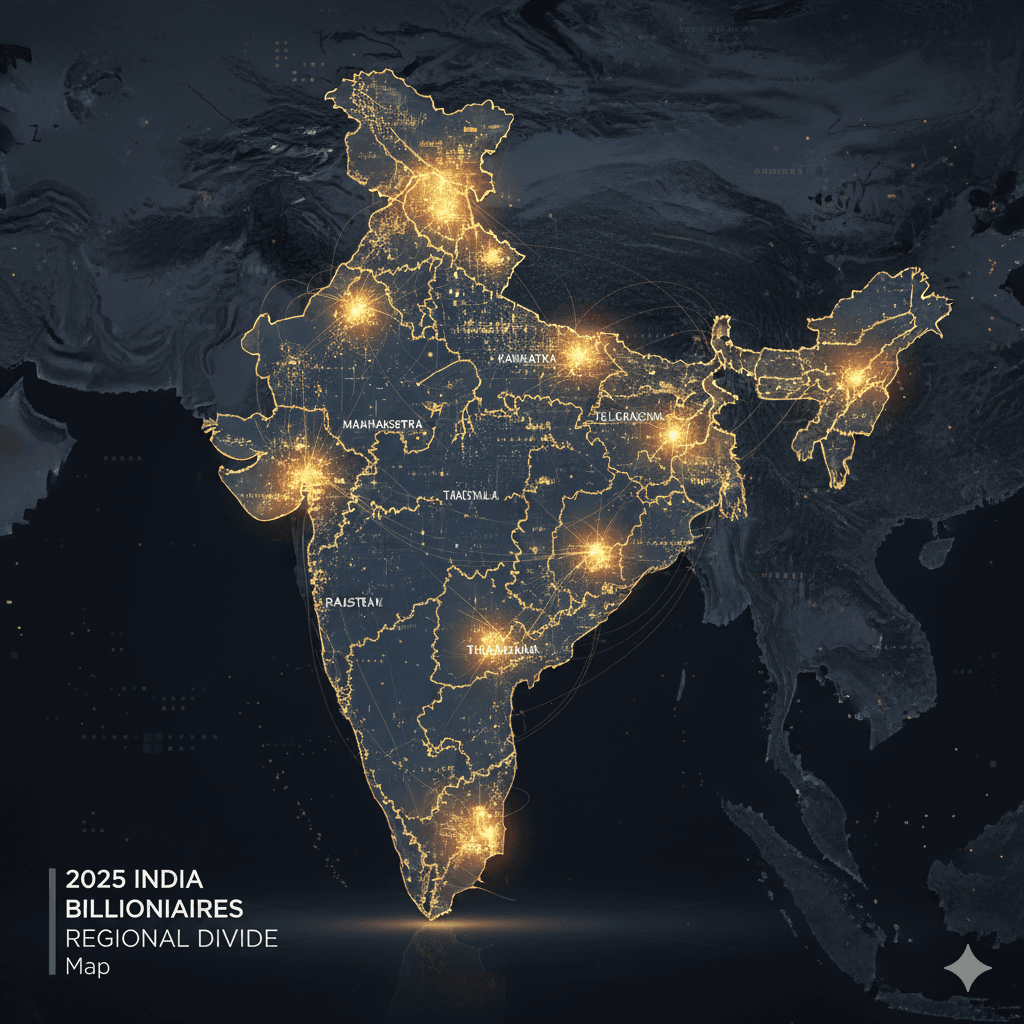The Uneven Canvas of Prosperity
India’s economy is a powerhouse, boasting 1,687 individuals with wealth over Rs 1,000 crore and 358 billionaires as per the 2025 Hurun India Rich List. Their combined fortunes rival half the nation’s GDP—a testament to entrepreneurial grit. Yet, peel back the layers, and a stark reality emerges: this wealth isn’t scattered across the country but funneled into a mere 10 states. Maharashtra, Delhi, Tamil Nadu, Karnataka, Gujarat, Telangana, West Bengal, Uttar Pradesh, Rajasthan, and Haryana claim over 90% of the riches, leaving the rest of India—from the Northeast to central plains—watching from the sidelines. This concentration isn’t just a statistic; it’s a mirror to deeper divides in opportunity, infrastructure, and ambition.
Table of Contents
- The Billionaire Hotspots
- Why Wealth Pools in a Few Places
- The Hidden Costs of Imbalance
- Paths to a More Inclusive Future
- FAQs
- Final Reflections
The Billionaire Hotspots
The Hurun list paints a vivid picture of geographic favoritism. Maharashtra tops the chart with 548 ultra-rich, fueled by Mumbai’s financial ecosystem. Delhi follows with 223, its corporate corridors buzzing with opportunity. Tamil Nadu and Karnataka, home to Chennai and Bengaluru, boast robust industrial and tech scenes, while Gujarat’s entrepreneurial spirit shines through. These five states alone hold over half the wealth, with the next five rounding out 90% of the total.
This clustering in metros like Mumbai, Delhi, and Bengaluru creates a self-reinforcing cycle: talent migrates, businesses scale, and capital flows, widening the chasm.
Table: Top 10 States by Ultra-Rich (2025 Hurun List)
| State | Ultra-Rich Count | Share of Total (%) |
|---|---|---|
| Maharashtra | 548 | 32.5 |
| Delhi | 223 | 13.2 |
| Tamil Nadu | 150 | 8.9 |
| Karnataka | 140 | 8.3 |
| Gujarat | 120 | 7.1 |
| Telangana | 90 | 5.3 |
| West Bengal | 80 | 4.7 |
| Uttar Pradesh | 70 | 4.1 |
| Rajasthan | 60 | 3.6 |
| Haryana | 50 | 3.0 |
Why Wealth Pools in a Few Places
Opportunity doesn’t spread evenly—it’s magnetized to hubs where infrastructure, talent, and capital converge. Mumbai’s stock exchange and banking nerve center draw entrepreneurs, while Bengaluru’s Silicon Valley vibe attracts tech innovators. These states benefit from better roads, airports, and digital access, creating a flywheel effect: more businesses mean more jobs, pulling in skilled workers and investors.
Migration amplifies this. Lakhs of young Indians flock to these centers annually, draining talent from hinterlands. Policy plays a role too—industrial corridors and IT parks cluster here, sidelining others. The result? A Gini coefficient of 0.55, where the top 10% hold 57% of wealth, per recent inequality studies.
Example: A startup in Ahmedabad accesses venture capital easily, scaling faster than one in Patna lacking similar networks.
The Hidden Costs of Imbalance
This lopsided prosperity breeds fragility. Overcrowded metros strain resources—housing costs in Mumbai are 20 times the national average—while lagging states see brain drain and stagnation. Socially, it fuels inequality, with rural-urban gaps widening. Economically, over-reliance on a few regions risks systemic shocks; a Mumbai downturn ripples nationwide.
The Hurun list isn’t just numbers—it’s a call to action. When wealth clusters, growth feels exclusive, eroding the inclusive vision of a rising India.
Paths to a More Inclusive Future
Bridging this divide requires deliberate steps. Invest in tier-2 cities with better infrastructure and incentives—think dedicated industrial parks in Indore or Guwahati. Promote digital access to level the playing field, and celebrate diverse success stories beyond metros. Policies like the Atmanirbhar Bharat push for localized manufacturing could decentralize opportunity, turning “watching” states into active participants.
Example: Rajasthan’s rising startup ecosystem, with 60 ultra-rich, shows how targeted support can spark growth.
FAQs
- How many billionaires in India? 358, per 2025 Hurun List.
- Top state for wealth? Maharashtra with 548 ultra-rich.
- Why the concentration? Urban hubs attract talent and capital.
- Impact of migration? Drains smaller states of innovators.
- How to fix it? Boost infrastructure in tier-2 cities.
Subscribe for Wealth Insights
Get weekly stories on India’s economic divide. Subscribe now!

